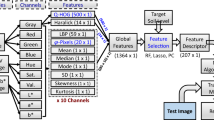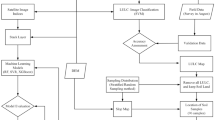Abstract
Precision farming is a systematic approach in agriculture that aims in improving economic and environment status of the farmers. It is achieved by having prior knowledge on soil texture, nutrient, pH and other climatic conditions. Hence this paper proposes a soil classification for crop prediction approach that uses an active contour algorithm for band estimation in Fourier domain for efficient texture feature extraction. This approach initially segments the soil sample and extracts into the color and texture features. The approach proposes a texture feature extraction where the image is initially transformed to Fourier domain of a 2D-discrete Fourier transform. The image in the Fourier domain is classified into high and low-frequency bands. The cut off frequency is decided by final contour of active contour method, where initial circular contour is used for estimating final contours on Fourier coefficients. This leads to the estimation of an irregular-shaped cut off frequency along with the 2D Fourier coefficients, instead of using a circular-shaped cut off frequency. A local binary pattern (LBP) from the high-frequency band image extracts texture feature. The extracted texture and color features are trained using a fully connected network. Active contour-based proposed model was evaluated by metrics F1-score, accuracy, specificity, sensitivity, and precision on soil datasets of Kaggle and IRSID. The accuracy, F1-score, specificity, precision, and sensitivity of proposed approach active contour-based were estimated as 97.89%, 97.87%, 99.46%, 98.11 and 97.94% respectively when evaluated in the Kaggle dataset. The evaluation results of proposed active contour model based soil classification outperform other traditional approaches.














Similar content being viewed by others
Data availability
Dataset supporting this study will be available https://www.kaggle.com/competitions/soil-types-classification-2020.
References
Srivastava P, Shukla A, Bansal A (2021) A comprehensive review on soil classification using deep learning and computer vision techniques. Multimedia Tools App 80(10):14887–14914
Romen Singh T, Roy S, Imocha Singh O, Sinam T, Singh Kh (2012) A new local adaptive thresholding technique in binarization. ar**v preprint ar**v:1201.5227
Gould S, T Gao, D Koller (2009) Region-based segmentation and object detection. Adv Neural Inf Process Syst 22
Uddin M, Hassan Md (2022) A novel feature based algorithm for soil type classification. Complex Intell Syst 1–17
Das S, Kharbanda K, Suchetha M, Raman R, Dhas E (2021) Deep learning architecture based on segmented fundus image features for classification of diabetic retinopathy. Biomed Signal Process Control 68:102600
Suchetha M, Sai Ganesh N, Raman R, Edwin Dhas D (2021) Region of interest-based predictive algorithm for subretinal hemorrhage detection using faster R-CNN. Soft Comput 25(24):15255–15268
Suchithra MS, Pai ML (2020) Improving the prediction accuracy of soil nutrient classification by optimizing extreme learning machine parameters. Inf Process Agric 7(1):72–82
Barman U, Choudhury RD (2020) Soil texture classification using multi class support vector machine. Inf Process Agric 7(2):318–332
Inazumi S, Intui S, Jotisankasa A, Chaiprakaikeow S, Kojima K (2020) Artificial intelligence system for supporting soil classification. Results Eng 8:100188
Yu Y, Xu T, Shen Z, Zhang Y, Wang X (2019) Compressive spectral imaging system for soil classification with three-dimensional convolutional neural network. Opt Exp 27(16):23029–23048
Barman U, Choudhury RD, Talukdar N, Deka P, Kalita I, Rahman N (2018) Predication of soil pH using HSI colour image processing and regression over Guwahati, Assam, India. J Appl Nat Sci 10(2):805–809
Dornik A, Drăguţ L, Urdea P (2018) Classification of soil types using geographic object-based image analysis and random forests. Pedosphere 28(6):913–925
Abraham S, Huynh C, Vu H (2019) Classification of soils into hydrologic groups using machine learning. Data 5(1):2
Rahman SAZ, Mitra KC, Mohidul Islam SM (2018) Soil classification using machine learning methods and crop suggestion based on soil series. In: 2018 21st international conference of computer and information technology (ICCIT), pp 1–4. IEEE
Shukla G, Garg RD, Srivastava HS, Garg PK (2018) An effective implementation and assessment of a random forest classifier as a soil spatial predictive model. Int J Remote Sens 39(8):2637–2669
Wu W, Li A-D, He X-H, Ma R, Liu H-B, Lv J-K (2018) A comparison of support vector machines, artificial neural network and classification tree for identifying soil texture classes in southwest China. Comput Electron Agric 144:86–93
Chernov V, Alander J, Bochko V (2015) Integer-based accurate conversion between RGB and HSV color spaces. Comput Electr Eng 46:328–337
Tian Y, Duan F, Zhou M, Wu Z (2013) Active contour model combining region and edge information. Mach Vis Appl 24(1):47–61
Rosten E, Drummond T (2005) Fusing points and lines for high performance tracking. In: Proceedings of the IEEE international conference on computer vision, vol 2, October, pp 1508–1511
Liu K, Kang G, Zhang N, Hou B (2018) Breast cancer classification based on fully-connected layer first convolutional neural networks. IEEE Access 6:23722–23732
Kiran Pandiri DN, Murugan R, Goel T (2021) Indian regions soil image database (IRSID): a dataset for classification of Indian soils. IEEE Dataport. https://doi.org/10.21227/2zz3-f173
Kaggle dataset: https://www.kaggle.com/competitions/soil-types-classification-2020
Albawi S, Mohammed TA, Al-Zawi S (2017) Understanding of a convolutional neural network. In: 2017 international conference on engineering and technology (ICET), pp 1–6. IEEE
Pegalajar MC, Baca Ruíz LG, Sánchez-Marañón M, Mansilla L (2020) A Munsell colour-based approach for soil classification using fuzzy logic and artificial neural networks. FUZZY Sets Syst 401:38–54
Zamani V, Taghaddos H, Gholipour Y, Pourreza H (2022) Deep semantic segmentation for visual scene understanding of soil types. Autom Constr 140:104342
Lanjewar MG, Gurav OL (2022) Convolutional neural networks based classifications of soil images. Multimedia Tools Appl 81(7):10313–10336
Afshin A, Huat Bujang BK, Hossein M, Nader S, Alireza P (2011) Changes of hydraulic conductivity of silty clayey sand soil under the effects of municipal solid waste leachate. Int J Phys Sci 6(12):2869–2874
Guo Z, Zhang L, Zhang D (2010) A completed modeling of local binary pattern operator for texture classification. IEEE Trans Image Process 19(6):1657–1663
Author information
Authors and Affiliations
Corresponding author
Rights and permissions
Springer Nature or its licensor (e.g. a society or other partner) holds exclusive rights to this article under a publishing agreement with the author(s) or other rightsholder(s); author self-archiving of the accepted manuscript version of this article is solely governed by the terms of such publishing agreement and applicable law.
About this article
Cite this article
G, S., Rajamohan, K. Soil classification using active contour model for efficient texture feature extraction. Int. j. inf. tecnol. 15, 3791–3805 (2023). https://doi.org/10.1007/s41870-023-01404-6
Received:
Accepted:
Published:
Issue Date:
DOI: https://doi.org/10.1007/s41870-023-01404-6




